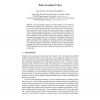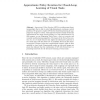29 search results - page 5 / 6 » Reinforcement Learning for Mapping Instructions to Actions |
ROMAN
2007
IEEE
13 years 11 months ago
2007
IEEE
— The ability for people to interact with robots and teach them new skills will be crucial to the successful application of robots in everyday human environments. In order to des...
ECML
2007
Springer
13 years 11 months ago
2007
Springer
We present Policy Gradient Actor-Critic (PGAC), a new model-free Reinforcement Learning (RL) method for creating limited-memory stochastic policies for Partially Observable Markov ...
NECO
2007
13 years 4 months ago
2007
Learning agents, whether natural or artificial, must update their internal parameters in order to improve their behavior over time. In reinforcement learning, this plasticity is ...
ECML
2006
Springer
13 years 9 months ago
2006
Springer
Abstract. Approximate Policy Iteration (API) is a reinforcement learning paradigm that is able to solve high-dimensional, continuous control problems. We propose to exploit API for...
MICAI
2010
Springer
13 years 3 months ago
2010
Springer
The full deployment of service robots in daily activities will require the robot to adapt to the needs of non-expert users, particularly, to learn how to perform new tasks from “...


